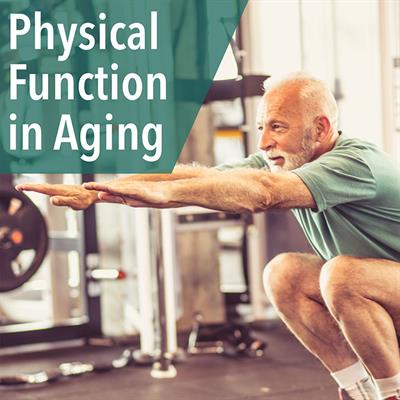Loretta DiPietro, PhD, MPH, FACSM |
Sept.
10, 2019
Despite the known benefits of physical activity to health and physical function in aging, the proportion of older adults meeting recommended physical activity guidelines remains low (27%). Since the 2008 Physical Activity Guidelines for Americans were published, considerable evidence has emerged regarding the relative benefits of various modes or combinations of physical activity, such as progressive resistance training, multicomponent exercise, dual-task training, tai chi, yoga, and dance, for fall-related injury prevention and for specific physical function outcomes (e.g., strength, gait speed, balance, activities of daily living [ADL] function). The 2018 Physical Activity Guidelines Advisory Committee (PAGAC) Scientific Report summarized this body of new evidence in order to inform the new 2018 Physical Activity Guidelines for Americans, 2nd edition. These findings were further summarized in the June issue of Medicine and Science in Sports and Exercise.
 The 2018 PAGAC Scientific Report provides strong evidence that physical activity reduces the risk of fall-related injuries in older people by 32-40%, and this includes severe falls requiring medical care or hospitalization. There is also strong evidence that physical activity improves physical function and reduces the risk of age-related loss of physical function in a dose-response manner among the general aging population and improves physical function in older people with frailty and with Parkinson’s disease. Moderate evidence indicates that for older adults who sustained a hip fracture or stroke, extended exercise programs and mobility-oriented physical activity improves physical function.
The 2018 PAGAC Scientific Report provides strong evidence that physical activity reduces the risk of fall-related injuries in older people by 32-40%, and this includes severe falls requiring medical care or hospitalization. There is also strong evidence that physical activity improves physical function and reduces the risk of age-related loss of physical function in a dose-response manner among the general aging population and improves physical function in older people with frailty and with Parkinson’s disease. Moderate evidence indicates that for older adults who sustained a hip fracture or stroke, extended exercise programs and mobility-oriented physical activity improves physical function.
The term “multicomponent” activity refers to physical activity interventions that include more than one type (or mode) of physical activity, with common types being aerobic, muscle-strengthening, and balance training. Perhaps the most convincing evidence from the 2018 PAGAC Report relates to the greater benefits of multicomponent (relative to single-component) exercise to the prevention of fall-related injuries and to improvements in physical function in older age. Moreover, multicomponent and multi-task activities (i.e., those that combine a physical task with a cognitive task) that are incorporated into the daily routine may be a promising alternative to structured, single-task exercise programs for older adults.
One in four individuals ages 65 years and older falls in the United States every year, and falls are the leading cause of fatal injury and the most common cause of nonfatal trauma-related hospital admissions among older adults. Thus, the effectiveness of physical activity programs that emphasize combinations of moderate-intensity balance, strength, aerobic, gait, and physical function training (performed in community settings or at home) for risk reduction has significant public health relevance in older age, due to the high prevalence of falls and fall-related injuries and fractures among older adults, as well as the consequent morbidity, disability and reduced quality of life.
Chronic diseases account for 75% of health care spending in the United States, and about 80% of adults ≥60 years of age have at least one chronic condition, and 77% have at least two. Low levels of daily physical activity often co-exist with chronic disease, thereby accelerating the risk of functional decline, disability, and mortality. Ample evidence now indicates that physical inactivity is among the strongest predictors of physical disability in older people. Aerobic, muscle-strengthening, and multicomponent physical activity appear to have the strongest relationship to improvements in physical function in the general aging population, as well as among those with chronic conditions. Thus, such activities may delay or improve mobility disability, frailty, and loss of independence in aging and also indicate that it is never too late to attain the benefits of an active lifestyle!
Learn More about the Physical Activity Guidelines for Americans 2nd Edition
Loretta DiPietro, PhD, MPH, FACSM, is a Professor in the Department of Exercise and Nutrition Sciences, the Milken Institute School of Public Health at The George Washington University. Dr. DiPietro received her training in epidemiology at Yale University. For over three decades, her research has focused on physical activity, and she has worked very hard to combine the two disciplines of epidemiology and physiology to better understand the mechanistic underpinnings of the benefits of exercise. Dr. DiPietro is recognized internationally as a leader in the field of physical activity and aging. An accomplished and widely published researcher, she has been awarded numerous grants from the National Institutes of Health and the American Cancer Society, and has been invited to lecture around the world. She is a current Fellow of the American College of Sports Medicine and the Editor-in-Chief of the Journal of Physical Activity and Health. In 2016, Dr. DiPietro was appointed to the United States Department of Health and Human Services 2018 Physical Activity Guidelines Advisory Committee and serves as the Chair of the subcommittee on Aging. In June of 2017, she received the American College of Sports Medicine Citation Award for her career accomplishments. Dr. DiPietro currently serves on the World Health Organization’s 2020 Guidelines Development Group for Global Physical Activity Guidelines.